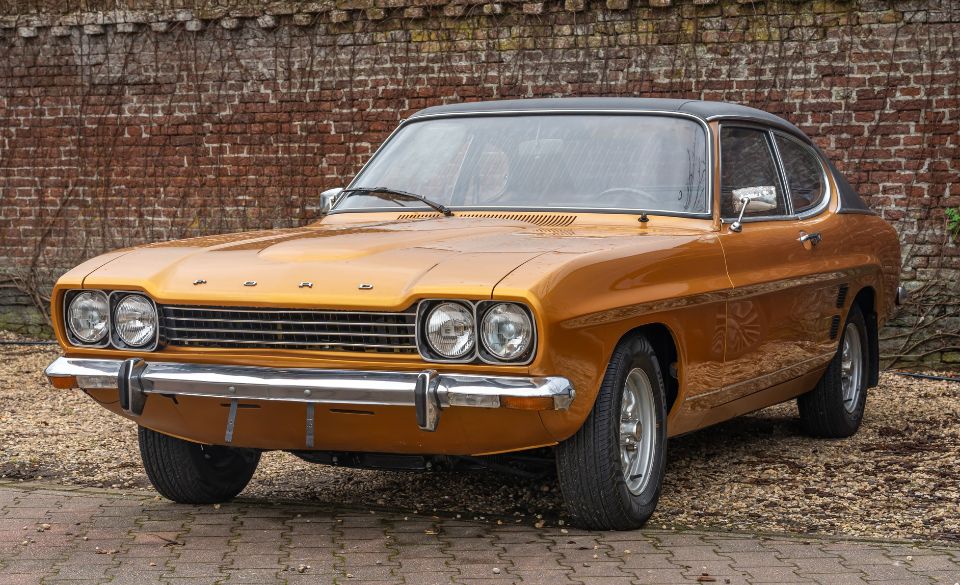The iconic Ford Capri, marketed as “the car you always promised yourself”, became one of the world’s most popular vehicles following its sensational launch at the Brussels International Motor Show in 1969.
In its first year of production at the Ford Europe plant in Halewood, UK, the public fell in love with the stylish auto, known as the “European Mustang” in honour of its American counterpart, snapping up 250,000 models.

© Milos Ruzicka / Shutterstock.com
By 1973, the Capri name became a legend, attracting a demographic of mainly young male buyers eager to impress their peers with this sporty, sleek and fast marque.
Following the launch of the new Ford Capri, an all-electric coupé crossover, in 2024, we’re taking a look at the history of this British cult classic and how it has won a place in the heart of every petrol head over the past half-century.
Birth of a legend
Back in 1968, American automotive designer Philip T Clark, who created the Ford Mustang for the US market, designed the Ford Capri. A fastback coupé, with MK 2 Ford Cortina mechanical components, the Capri MK 1 debuted in January 1969 and went on sale one month later.
As well as being built at Britain’s Halewood plant, more cars were rolling off the production line at Ford’s factories in Belgium and Germany. Filling the gap between the family saloon and two-seater sports car, the Capri was highly desirable thanks to its wide range of engines, starting with a standard 1.3-litre and going up to a powerful 3.0-litre V6. The basic 1300 model cost £890, while the top-of-the-range car was £1,310.
The manufacturer made constant improvements including a tailgate replacing the traditional boot lid in 1974, additional soundproofing; larger side windows to benefit back seat passengers; and power-assisted steering. The luxury 2.0-litre and 3.0-litre Ghia versions included tinted glass, alloy wheels and a sunroof, and the performance of top-of-the-range models was improved, with a top speed of 116mph and a capability of reaching 0-60mph in nine seconds.
In 1978, as a result of a research programme into aerodynamics, the Capri was made more energy-efficient and given more attractive, smoother lines. A laminated windscreen was made standard across all models, and the improvements in aerodynamics led to a faster top speed of 122mph.
New fuel injection model
The new Capri 2.8i debuted at the Geneva Motor Show in 1981, after being developed by the Ford Special Vehicle Engineering group. Its 2.8-litre V6 engine was enhanced with Bosch K-Jetronic fuel injection, with other improvements including thicker anti-roll bars, lowered suspension, a five-speed gearbox, wide-rim alloy wheels, Goodyear 205/60VR NCT tyres and gas-filled shock absorbers.
From 1984, ventilated disc brakes were introduced for the front wheels, with a test team from Autocar enthusing about how it rocketed from 0-60mph in 7.9 seconds. During the same year, the Capri 2.8 Injection Special was launched, featuring seven-spoke alloy wheels, later paving the way for the high-performance Capri 280.
While it had been hugely successful, by the early-1980s, the Capri was overshadowed by the arrivals of “hot hatchbacks” on the market and sales faltered. In 1986, production of the Capri in Europe stopped, with the final model being the Brooklands Green limited edition 280, after releasing multiple variations under the MK II and MK III marques for 17 years.
The final Capri of the era was made at Ford’s Cologne factory in Germany on 19th December 1986, after an incredible 1.8 million had been manufactured. The last one, registration plate D194 UVW, is still going strong - owned by Ford’s own Heritage Workshop.
Famous Ford Capris
The iconic TV comedy show, Only Fools and Horses, featured Del Boy’s 1980 Ford Capri MK III. His 2-litre Ghia was a flashier car in contrast with his regular yellow Reliant Regal van. Thanks to Del’s efforts at customisation, Rodney nicknamed it the “Pratmobile”! Today, it is owned by the British Motor Museum.
Celebrity chef Jamie Oliver owned and restored a 1970 Ford Capri 3000GT MK I to its original specifications after buying it in 2014. The car was sold at auction ten years later for £28,000.
How many Ford Capris are left?
Now extremely rare, there are only around 2,000 vintage Ford Capris with a valid MOT left on Britain’s roads. The most common models are the 1600 XL, 1600 GT, Capri 280, 3000 GXL and Capri GL. The rarest include the 3000 GTS Automatic, Capri GT XL, Cabaret Automatic and 1600 GL Automatic.
It’s possible to have your classic car retrofitted with modern accessories to aid safe driving including a Ford backup camera and parking sensors. A retrofit expert, such as Autologics, can install a Ford reverse camera, or a Ford tracker to combat theft, giving your classic car the benefits of new technology.
New electric model
Ford’s new all-electric Capri is being promoted as having a “sports car soul in a practical SUV”. A coupé crossover with advanced technology, it features an all‑day driving range and is available in two series, the Select and Premium models.
A great all-round vehicle, whether it’s a classic or new electric, the Ford Capri will appeal to a whole new generation of car owners more than 50 years after it first rolled off the production line.

